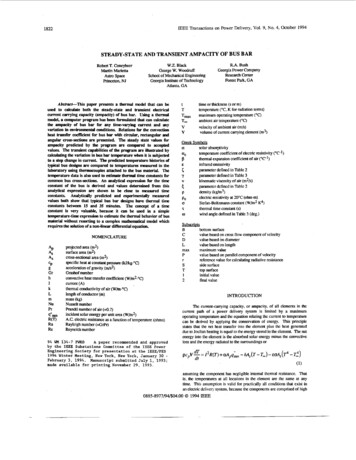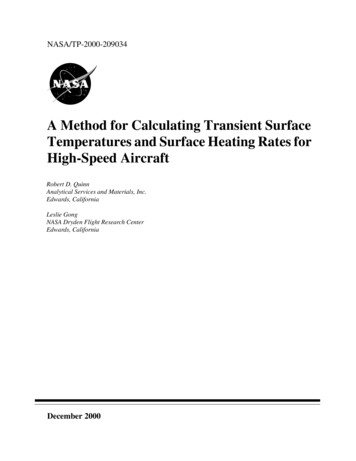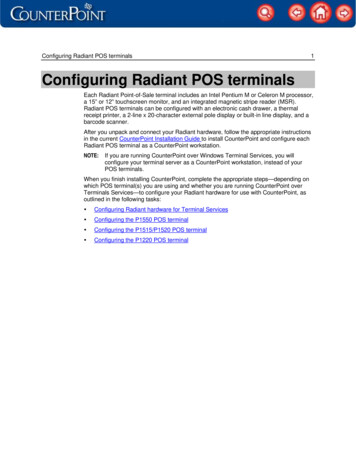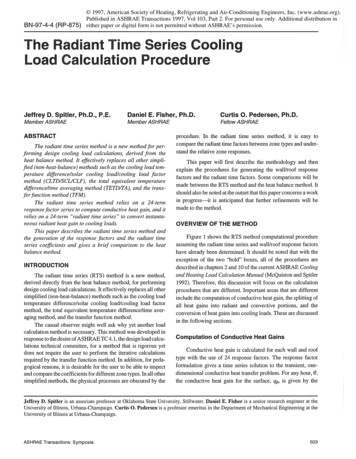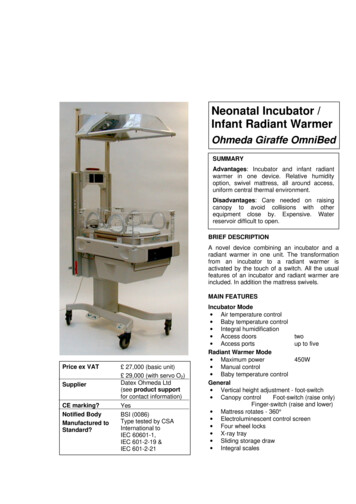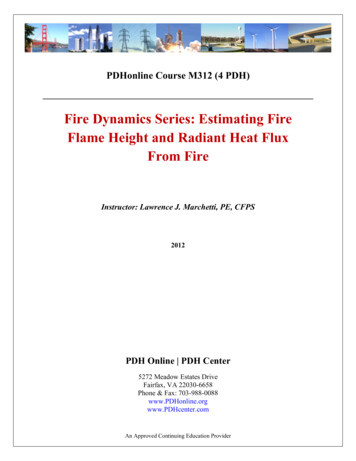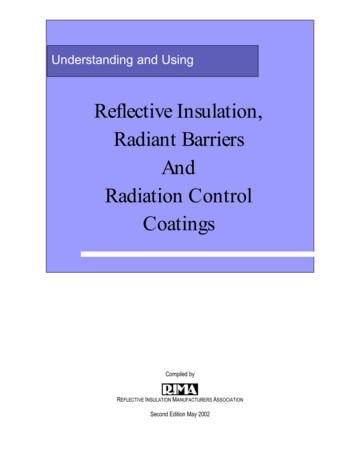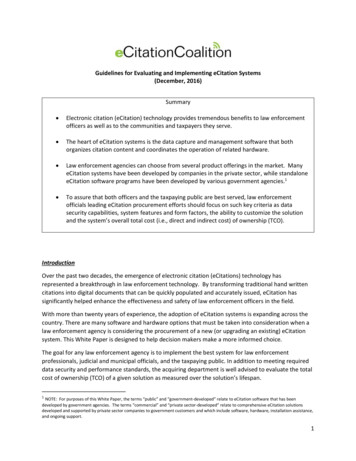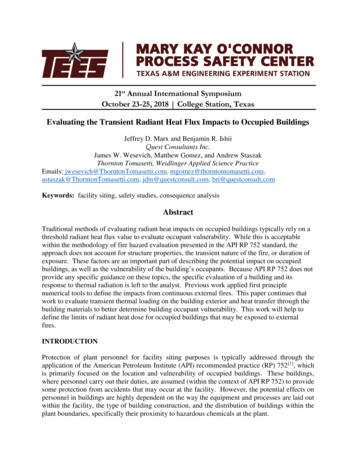
Transcription
21st Annual International SymposiumOctober 23-25, 2018 College Station, TexasEvaluating the Transient Radiant Heat Flux Impacts to Occupied BuildingsJeffrey D. Marx and Benjamin R. IshiiQuest Consultants Inc.James W. Wesevich, Matthew Gomez, and Andrew StaszakThornton Tomasetti, Weidlinger Applied Science PracticeEmails: jwesevich@ThorntonTomasetti.com, setti.com, jdm@questconsult.com, bri@questconsult.comKeywords: facility siting, safety studies, consequence analysisAbstractTraditional methods of evaluating radiant heat impacts on occupied buildings typically rely on athreshold radiant heat flux value to evaluate occupant vulnerability. While this is acceptablewithin the methodology of fire hazard evaluation presented in the API RP 752 standard, theapproach does not account for structure properties, the transient nature of the fire, or duration ofexposure. These factors are an important part of describing the potential impact on occupiedbuildings, as well as the vulnerability of the building’s occupants. Because API RP 752 does notprovide any specific guidance on these topics, the specific evaluation of a building and itsresponse to thermal radiation is left to the analyst. Previous work applied first principlenumerical tools to define the impacts from continuous external fires. This paper continues thatwork to evaluate transient thermal loading on the building exterior and heat transfer through thebuilding materials to better determine building occupant vulnerability. This work will help todefine the limits of radiant heat dose for occupied buildings that may be exposed to externalfires.INTRODUCTIONProtection of plant personnel for facility siting purposes is typically addressed through theapplication of the American Petroleum Institute (API) recommended practice (RP) 752 [1], whichis primarily focused on the location and vulnerability of occupied buildings. These buildings,where personnel carry out their duties, are assumed (within the context of API RP 752) to providesome protection from accidents that may occur at the facility. However, the potential effects onpersonnel in buildings are highly dependent on the way the equipment and processes are laid outwithin the facility, the type of building construction, and the distribution of buildings within theplant boundaries, specifically their proximity to hazardous chemicals at the plant.
An analysis conducted to satisfy API RP 752 generally should include three classes of hazards: Explosion overpressure or blast wave exposure Fire radiation exposure, including pool fires, jet fires, and exposure to an ignited flammablevapor cloud (flash fire) Toxic gas exposureThe focus of this work is specifically addressed towards exposure to fire radiation from continuousfires whose radiant impact changes over time (a transient heat flux).BUILDING SITINGThe methodology and tools available for safety siting studies are generally well known within theprocess safety community. The methodology can be structured as a staged process that allows thestudy to stop at multiple points when the analysis shows that the impacts, or risk, to the subjectpopulation (building occupants) is found to be tolerable. These methodologies have beensummarized in several published papers[2] [3].The specifics of radiative loading on buildings has been addressed by various internationalagencies[4] [5] [6]. In these publications, the vulnerability of building occupants was estimated usinga fixed value of thermal radiation (e.g., 35 kW/m2) without any mention of the duration ofexposure.FIRE RADIATION IMPACTSOccupied buildings can be impacted by many forms of fire radiation including: Fireballs due to instantaneous releases of flammable fluids, including boiling liquidexpanding vapor explosions (BLEVEs)Vapor cloud fires (flash fires) due to a release that forms a flammable vapor cloudJet (torch) fires due to continuous, pressurized releases of flammable fluidsPool fires due to pooled releases of flammable liquidsOf these fire types, jet fires and pool fires are typically the dominant types considered as a threatwithin a building siting study. Buildings within a vapor cloud fire are typically not exposed longenough to ignite the building, even if it is constructed of flammable materials. Fireballs, in additionto their short duration, are historically rare events and are typically not considered a credible threatto occupied buildings. It is the long duration jet and pool fires that pose a threat to buildingsthrough flame contact or high levels of thermal radiation.The vulnerability of building occupants to fire radiation is certainly mitigated by the building beinga physical barrier to the direct effects of fire radiation. However, there are several concerns forthe building itself that affect occupant vulnerability: Building materials that are combustible could be ignited if the radiative flux and exposureduration are sufficient;
The integrity of non-combustible materials can be compromised due to degradation ordeformation following exposure to radiative heat flux for a sufficient exposure time,resulting in building collapse; or,The increased temperature of the building shell exposed to thermal radiation results in asignificantly increased interior temperature.In all cases of exposure to thermal radiation, the magnitude of the radiative flux and the durationof exposure are equally important variables. The principle behind this, whether the exposure isburns to a person’s skin, ignition of wood, or weakening of structural steel, is the temperature risethat occurs.The exposure of occupied buildings to high levels of fire radiation, such that it could adverselyaffect the building occupants, is the focus of this analysis, including the complex techniquesrequired to evaluate building impacts due to fire radiation, such that the impacts to occupants canbe evaluated. The precursor to this work[7] began addressing the issue of radiative loading tooccupied buildings by evaluating a section of a typical pre-engineered metal building (PEMB)during external thermal radiation loading with durations up to an hour. The findings of that workincluded: Steady-state conditions were observed in the structural steel within about 10 minutes forthe scenarios modeled.Insulated PEMBs may suffer damage to the exterior panels, but are not expected toexperience any structural degradation under long-duration exposure to radiant loading upto 100 kW/m2.Uninsulated PEMBs exposed to radiant heat fluxes greater than 35 kW/m2 may experiencea loss of structural integrity within about 5 minutes of exposure, such that buildingoccupants could be threatened.Structural members in uninsulated PEMBs can reach temperatures that may be capable ofigniting flammable materials in the interior of a building.CONTINUING STUDYTo further evaluate the potential impacts to PEMBs, and thus the vulnerability of buildingoccupants, this work sought to further investigate the potential impacts of transient heat fluxloadings on a subject building.Accidental Fire LoadingIn order to study transient heat flux loadings, a dynamic system that is often found in processfacilities was modeled to better represent realistic plant hazards. For this reason the modelingpackage CANARY by Quest was used to calculate the transient release rate and the transientrelease conditions accounting for the thermodynamics of the releasing system. In addition,CANARY by Quest was used to model the thermal radiation from transient jet fires.The characteristic jet fires were modeled based on a release from a propane storage vessel.The vessel is used to store propane as a liquid, at atmospheric temperature and elevated pressure.
A two-inch hole is assumed to occur in the piping connected to the liquid side of the storage vessel.Within seconds, the release is ignited and forms a jet fire. The release flow rate drops quickly inthe first two minutes as the system depressurizes. The rate continues to drop and at 28 minutesthe flow rate reaches a value that is half of the initial flow rate. As the flow rate and pressure dropthe jet fire shrinks in size, and the thermal radiation impacts shrink accordingly.Figure 1 shows the thermal radiation at four separate points near the jet fire. The position of thesefour points are static relative to the release point (storage vessel). Not all points near the jet fireexperience the same reduction in thermal radiation as the flame shrinks. As the jet fire shrinks thereduction in length is greater than the reduction in diameter or lateral dimensions. Thus, the pointsnear the end of the initial flame will experience a larger drop in radiation than near the source ofthe jet fire.Figure 1. Transient Radiation Load Cases A-DComplex AnalysisThe potential impacts from fire radiation described above were investigated using the numericalheat transfer tools contained in a finite element analysis (FEA) model. Based on the FEA results,the temperature rise in construction materials exposed to an external fire can be estimated.Resulting temperatures can be used to determine the potential for ignition of constructionmaterials, integrity loss of exterior construction elements, and integrity loss of the main structuralframing members.
The performance of a typical PEMB exposed to transient thermal radiation loading external to thebuilding is evaluated in this study. In the scope of this paper it is assumed that the fire eventhappens outside the building, exposing the building wall to a heat flux. The vertical cladding ofsuch buildings would typically be constructed of exterior corrugated metal panels screwed tohorizontal girts that span approximately 20 feet between columns. Depending on the building,insulation may be installed between panels and the building frame. This analysis will address bothinsulated and uninsulated structures, and it is assumed that a large portion of the exterior surfaceof the building wall is exposed to these heat fluxes.Calculation MethodologyHeat flux from the fire flows from outside to inside the building wall. Due to the high temperatureof the flame, radiation dominates the heat flow from the fire to the exterior surface facing the fire.Re-radiation of the exterior surfaces is also considered. External convective effects are ignoredfor this analysis due to the dominance of radiative heat transfer. At the exposed surface, heat istransferred through the solids by conduction. The interior surfaces, not exposed directly to fireradiation, release heat through radiation and convection to the surrounding interior air at lowtemperature (initially at ambient temperature). The air medium inside and outside the PEMBcladded wall are not explicitly modeled in the FEA.To model heat radiation, for each radiative heat flux scenario, the methodology presented in thepredecessor paper (reference 7) was applied. In each case, the equivalent incident thermalradiation equal to the values presented in Figure 1, varying with time, were applied to the externalsurface.Conduction of heat through the solid body of the wall (construction material) results in atemperature change of the wall. The conduction equation is used within the FEA software tocalculate the temperature change, where conduction depends on the specific heat, density, andmost importantly, thermal conductivity, of the materials in the wall structure.Once the temperature of the interior surface of the PEMB wall rises above its initial temperature,heat flows to the interior space through radiation and convection. Depending on how hot the wallmaterials get, internal heat flux may be dominated by radiation or convection. Since the air insideand outside the PEMB wall are not explicitly modeled, an assumption for the building internaltemperature must be made, as well as emissivity of the internal surface and convection coefficientof the inside air.Calculation ModelThe PEMB wall considered in this study includes 26 gauge vertical spanning metal R-panels(structural panels used primarily for PEMBs roof and wall construction) screwed to horizontal8x25z16 girts at 4 feet on center vertically. For the purpose of this paper, only a 2-foot by 4-footarea of the wall is modeled. Wall insulation is also modeled and it is assumed that the compressedthickness of the insulation at the girt location is ¾ inch, and elsewhere is a full 3 inches. It isassumed that the panel is screwed to the girt with #10 screws at every foot, and the equivalent areaof the screws are included in the model. The Abaqus FEA software[8] was used to perform the
heat transfer analysis. Geometry of the model is shown in Figure 2. More specifically, 8-nodelinear heat transfer brick elements are used to mesh the geometry.Figure 2. Geometry of the Modeled Portion of the PEMB Wall(Exterior and Interior, with Insulation)Based on several manufacturers’ available data, an R-value of R-10 was used for the 3-inch thickinsulation. Squeezed insulation at the girt location is assumed to have R-value of R-5.Temperature dependent thermal material properties are used based on Eurocode 4[9] specifications.For all heat flux scenarios, the exterior face of the wall panel was exposed to heat flux for a durationof greater than 15 minutes according to the transient heat flux curves presented in Figure 1.Overall, 5 different cases are defined. One case is a wall structure with insulation exposed tothermal load A at the exterior surface, and exposed to 25 C room temperature at the interiorsurface. Four other cases include a wall structure without insulation exposed to thermal loads A-Dat the exterior surface, and exposed to 25 C room temperature at the interior surface.STUDY RESULTSThe results of the simulations show the transient temperature variation in the modeled portion ofthe wall exposed to a range of transient heat fluxes. The results of an insulated wall exposed tothermal load A is shown in Figure 3. For compa
Because API RP 752 does not provide any specific guidance on these topics, the specific evaluation of a building and its response to thermal radiation is left to the analyst. Previous work applied first principle numerical tools to define the impacts from continuous external fires. This paper continues that work to evaluate transient thermal loading on the building exterior and heat transfer .


